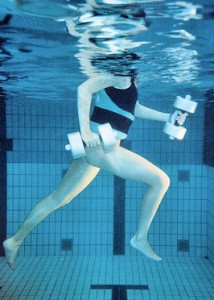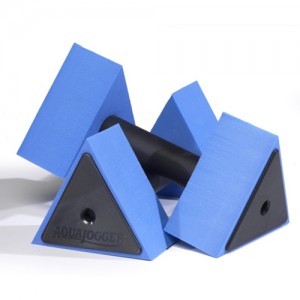It was a slice of heaven.
A time when sneaking into the pool at a Palm Springs hotel was only half the fun. The other fun was sipping a cold ice tea lying on a lounge chair under the brilliant sun while being sprayed with Evian water by the hot-looking cabana boys.
It was a time when my friend and I laughed immensely after listening to the attendants nearby whisper into their walkie-talkies, “Copy that, it’s definitely Code Brown” after having evacuated the pool of its splashing participants.
It was never my thing to swim in water where little diaper-less kids roamed, but elsewhere given a beautiful sparkling blue pool I was truly lost in paradise.
I love being in water, whether it’s an ocean, river or pool. And so it is no surprise I was on my high school, city and college swim teams, certainly never Olympic material, but the experience of gliding (hard) every day through the water was beautiful.
 These days I’m still near water–on deck at pools guiding people through water aerobic classes, a fun and low impact way to exercise. It’s been slowly gaining credit as a very viable way to keep in shape other than for rehabilitation. And the geriatric stigma is losing way to smart younger crowds who understand the benefits of this exercise and the fun that goes with it.
These days I’m still near water–on deck at pools guiding people through water aerobic classes, a fun and low impact way to exercise. It’s been slowly gaining credit as a very viable way to keep in shape other than for rehabilitation. And the geriatric stigma is losing way to smart younger crowds who understand the benefits of this exercise and the fun that goes with it.
Sweating it out on land, gravity pulling at every move, was something I was good at avoiding, using cycling and swimming as my way to get around the weight bearing physics of working out.
I still advocate walking on land at a steady pace for bone health since water exercising does not increase bone mass. But because the buoyancy of water does eliminate 90% of the body’s weight, moving around is a snap, and a good and honest workout is still possible.
The burden put on stress-bearing joints and muscles is very nominal and for this reason water aerobics is less likely to cause injury or extreme muscle soreness.
Many who have taken an aqua class complain it doesn’t get the heart rate up high enough for them. Thing is, when exercising in water, the heart rate tends to be around 17 beats per minute less then when exercising on land. So though your heart rate working out in water may seem too low, the workout is still quite intense.
Pay attention instead to the workout and its movements rather than the heart rate. There is continual resistance to every move in the water, 12-14 times more than on land, so the body gets toned, balanced and flexible in every move made.
Lung capacity is improved by the pressure of the water on the chest, making the lungs work harder to expand. Circulation improves and along with it, a stronger heart. 
But best of all, water disperses heat much more efficiently than air, so there is less chance of overheating, keeping the body cooler and more comfortable than on land.
Deep water aerobics is a powerful way to get in shape faster, but for many who are intimated with nothing under their feet, shallow water aerobics is great. Tips for shallow: water levels need to be mid-chest and never run or jump on your tip-toes, and be sure to always bring your heal completely down to the pool floor.
For an aqua class, all you need is to don a bathing suit, aqua shoes for those with tender feet, and get in the water, which ideally should be set to 82 degrees.
But there are extra pieces of equipment to give a better workout such as aqua bells (floating dumbbells that offer greater resistance), aqua belts (for deep water workouts), webbed gloves, resistance cords, noodles, kickboards, and ankle weights. Many fitness clubs already provide these and include them in the workout.
Though you can work out in your pool at home, it is so much more fun with a group–the music entertaining and the instructor a contagious inspiration with enthusiasm for everyone.
Check your local fitness clubs or city pools for classes near you.
Columnist Gina Dostler can be reached at Ima_gina_tion@yahoo.com.




